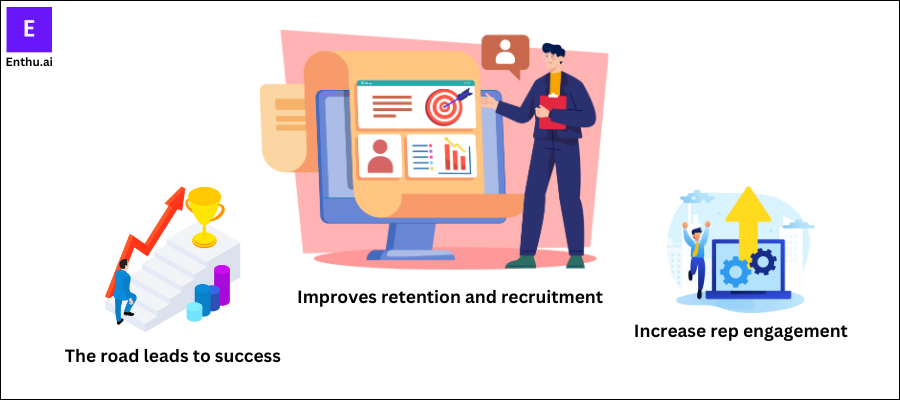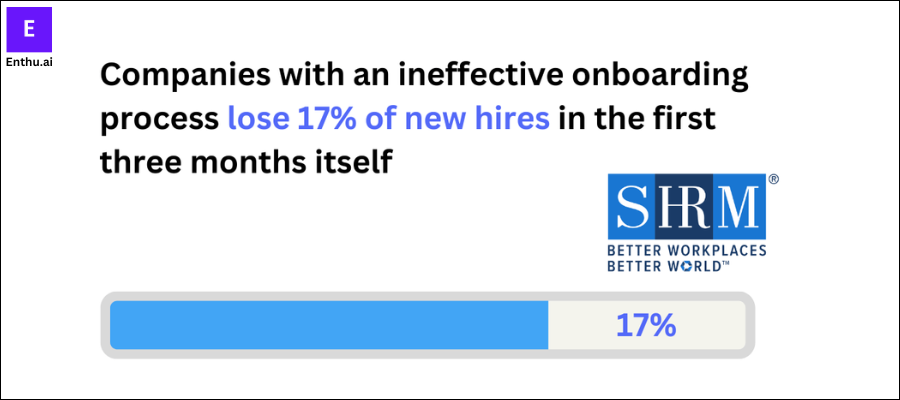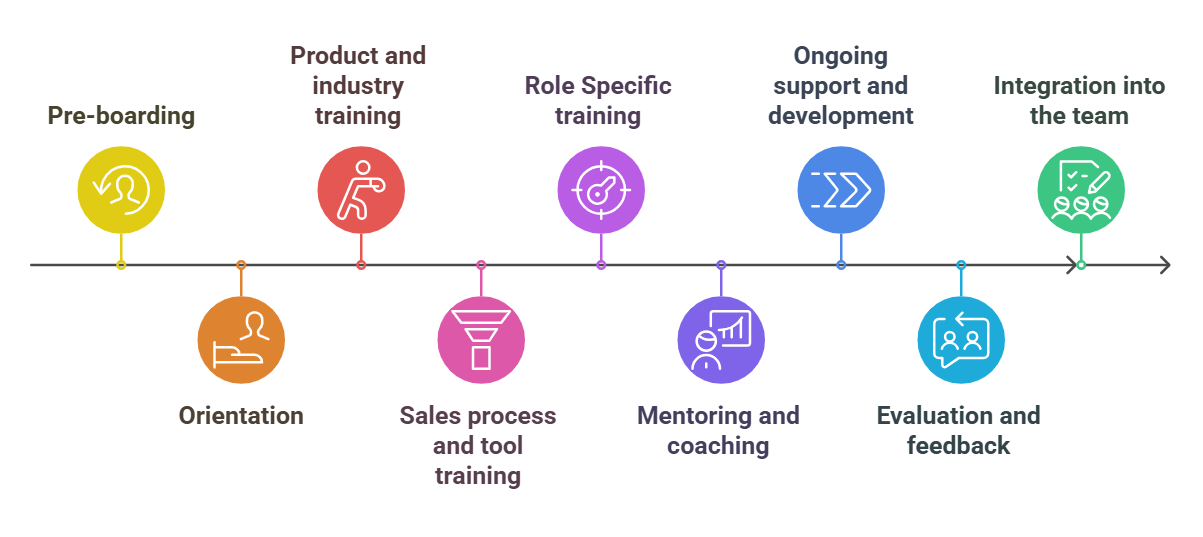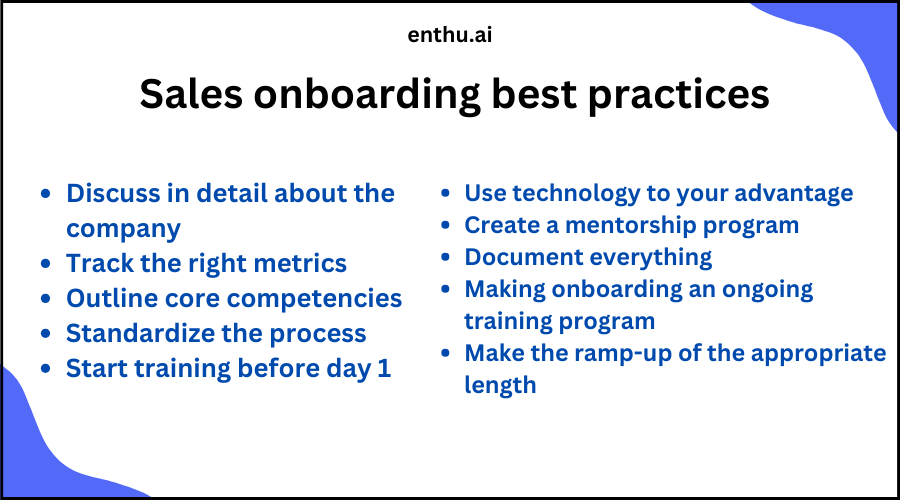A major hurdle for every sales manager is to find the right rep for their team.
On average, it takes 381 days to train a new sales rep, and their tenure generally doesn’t last more than 2.5 years.
It proves to be a costly affair for the organizations in terms of time, money, and effort.
However, this can be changed by conducting a smooth sales onboarding process.
Table of Contents
A. What is sales onboarding?
Sales onboarding is the method of equipping new sales hires with the knowledge and skills required to perform effectively and reach their goals.
These skills are focused on making them competent and confident that reflected during every potential client/customer interaction.
A well-designed onboarding program has defined learning objectives in consumable chunks, and it is readily updated with all the latest products and competitor’s information.
Research has shown that 69% of employees tend to stay more than three years if they have a great onboarding experience.
B. Benefits of sales onboarding
Let’s look at why every organization needs to pay extra attention to their sales onboarding process.

1. The road leads to success
When you have an onboarding process that aligns with your organizational needs, it really leads your sales reps to greater success.
For starters, they know what types of products or services they are selling. And second, they have the knowledge and skills to perform diligently.
Not only that, but it also ensures that your sales reps are well-equipped with information about the current as well as potential customers to enhance their creative thinking capability.
Furthermore, when the company’s values and missions are clearly stated, sales reps feel confident in their product.
2. Improves retention and recruitment
One of the significant challenges most hiring managers face is finding and retaining the top talents in the industry.
In general, the average turnover cost per sales rep is $97,690, including recruiting costs, training costs, and lost opportunities.
The key to retaining your sales reps is by offering effective onboarding and training programs. You can keep your employees for years by providing them with consistent onboarding experience and updating their knowledge bank to help them succeed in their jobs.
For added support, consider working with the best sales recruiters to create a seamless and impactful onboarding experience.
In other words, a strong onboarding curriculum sets you apart from the rest of the company.
In fact, companies with an ineffective onboarding process lose 17% of new hires in the first three months.

3. Increase rep engagement
It’s a proven fact that when a new hire gets a good onboarding experience, they are more likely to engage actively with the company’s goals.
When sales reps have all the required tools and information at their disposal, they are able to satisfy their clients by engaging with them effectively.
Not only that, they also help other sales reps to succeed and brainstorm ideas to improve the overall sales positioning strategy.
Such engaged sales reps are an asset for your company as they form the most integral part of your sales department.
Check how Enthu.AI helps you improve your sales process
C. Sales onboarding process
Now that you know the importance, let’s delve into how you enhance the sales onboarding experience for all your hires.
The term “sales onboarding process” refers to a systematic and structured strategy of integrating new sales professionals into a firm and providing them with the necessary knowledge, skills, and resources to become effective and productive members of the sales team.
In most cases, the onboarding process starts when a new salesperson is hired and lasts for a specified amount of time, usually several weeks or months, depending on the complexity of the role and the unique requirements of the organization.
Here are the key steps involved in the sales onboarding process:

1. Pre-boarding
This stage occurs before the new salesperson joins the company. This involves administrative tasks such as filling out paperwork, setting up equipment and software access, and disseminating important information about the first day of work.
2. Orientation
The new salesman attends a formal orientation program on their first day. This could involve getting to know the important team members, taking a look around the office or other facilities, learning about the values and culture of the business, and learning about the structure and objectives of the team.
3. Product and industry training
New salespeople must have a thorough awareness of the products and services that they will be selling along with the industry and marketplace. This training may involve Presentations, documentation, practical exercises, and shadowing seasoned salespeople.
4. Sales process and tool training
It is essential to educate new hires about the organization’s sales process, methodology, and customer relationship management software. This includes instruction on prospecting strategies, sales enablement tools, lead management, objection handling, and deal closing.

5. Role Specific training
Additional training can be given, depending on the salesperson’s specific position within the sales team. Training on specialized products, target consumer groups, or sophisticated sales strategies may fall under this category. The training should be consistent with the goals and responsibilities of the salesperson.
6. Mentoring and coaching
A mentor or coach makes a significant difference in the new salesperson’s onboarding process. A mentor helps a new hire overcome obstacles, form relations, and quicken their learning curve by offering guidance, motivation, and feedback.
7. Ongoing support and development
The initial training period should not be the end of the onboarding process. By providing ongoing support, continuous learning opportunities, and regular performance assessments, new sales reps may fine-tune their abilities, fill the gaps, and stay updated on industry trends and best practices.
8. Evaluation and feedback
Regular evaluation and feedback sessions allow the salesperson and their management to analyze progress, identify areas for development, and set growth goals. These discussions help to align expectations and ensure that the new hire is on pace to achieve their objectives.
9. Integration into the team
Encouraging social integration and fostering relationships within the sales team and other relevant departments is essential for long-term success. Activities such as team-building exercises, networking events, and cross-functional collaborations can facilitate integration and collaboration.
E. 10 Sales onboarding best practices

1. Discuss in detail about the company
It’s crucial that your employees share the same vision, mission, and goals of your company.
Failing to align with the goals of the company, the whole process of recruiting and training a person will be a wasted effort.
While handing them the employee handbook, add your company’s mission statement and list all values on it.
If you don’t have a printed version, you can always explain it in the orientation session.
2. Track the right metrics
Measure your new rep’s performance by using set KPIs.
After they have completed their onboarding process, you need to start tracking the right metric to measure their performance.
For instance, you can look at how long it took to complete their first deal, how many leads are booked for the demos, whether are they following the script theme, and so on.
This is particularly important to also decide the effectiveness of your onboarding program. If your new hire’s performance result is low, you may want to revisit your onboarding process and determine what needs improvement.
Besides, it gives you a picture of their selling capabilities in the early stage itself.
3. Outline core competencies
Every company should have a clearly defined list of core competencies they are looking for in sales reps.
Not every company prioritizes the same thing.
For instance, some companies value selling techniques, whereas some put more stress on in-person conversational skills to close more deals.
The senior sales reps and manager can help decide your company’s core competencies as they will know better what skills are needed to make the new hires as engaging and active as possible.
4. Standardize the process
Onboarding a new sales hire is not a one-day event. In fact, it can even take up to six months in some companies.
It’s essential to map out and standardize the whole process so that new hires will know what is in store for them. To do that, ask yourself questions like –
Which training courses do they need to complete in the first week itself?
What should their target goals be like in the first quarter?
Even though every company’s onboarding process will be unique, they all share the same aspects.
Those are –
- Defining company culture
- Educating about products and offerings
- Explaining the detailed sales cycles and processes
- Getting familiarized with team structure and sales project length
- Imparting knowledge of the company’s history, buyers’ persona, & sales quota
5. Start training before day 1
Pre-boarding is the process of making content available to your new sales reps before they even start at your company.
Not every company is into pre-boarding, and is often considered a controversial thing.
However, if we talk about sales reps, pre-boarding can help them learn your sales process & software quicker than the expected time period. This will enable them to start selling faster.
6. Use technology to your advantage
As millennials are taking over the workforce, they will appreciate technology in their onboarding process.
There’s no denying that onboarding isn’t exhausting. It can be. However, by introducing technology to the whole process, you can streamline the entire process with ease.
For instance, you can easily keep track of the new hire’s training process. Moreover, you can use technology to make the process of sales onboarding interesting for your new hires.
Try including videos in the training module, or leverage your CRM and scheduling tool to the full advantage.
7. Create a mentorship program
If you want to retain your sales reps, the key is to make them feel valued.
When you establish a one-to-one senior mentor for your new hires, it sends the message that you care about their long-term career development. Besides, it is a great way to keep them engaged within your organization.
However, once you have set up the initial meeting between a mentor and mentee, allow the relationship to take its own course. Check-in at regular intervals to see how the mentorship is going.
If you don’t see any significant progress or change, you might consider changing the mentor.
8. Document everything
You can’t expect a new sales hire to remember everything they are presented with during onboarding.
When you document everything, it becomes a permanent and physical point of reference for them to check in case of any queries. This results in successful onboarding.
Equip them with resources that contain guides and references to sales objection documents and the best ways to respond to them.
9. Making onboarding an ongoing training program
The onboarding process is not a one-time thing. Instead, it is an ongoing process.
Studies have shown that organizations with ongoing training programs are likely to perform better than those that don’t.
For sales reps to close more deals, they need to master the skills of asking the right sales questions and understanding the prospect’s problems.
This, of course, comes with experience. However, by providing continuous training on how the company’s products work or how they can solve a prospect’s problem, you can enhance their effectiveness.
10. Make the ramp-up of the appropriate length
The best way is to use previous data to determine the length of your sales cycle. It is important to note that not every sales type has the same ramp-up period.
Large deals generally can take up to nine months, whereas transactional deals can only take a month.
Based on this information, set up different milestones at different steps of the onboarding process. Clearly communicate these goals to your new reps and provide guidance to help them achieve those milestones.
Conclusion
Once you have completed the sales onboarding process, take employees’ surveys on it.
It will help you identify the areas that need improvement. This way, you can continually assess the effectiveness of your onboarding program.
FAQs
1. What is the onboarding process in sales?
The onboarding process in sales refers to the steps taken to integrate and train new sales team members, providing them with the necessary knowledge, skills, and resources to succeed in their role.
2. What are the 4 phases of onboarding?
The four phases of onboarding typically include orientation (introduction to the company), training (learning product/service knowledge), mentorship (guidance from experienced colleagues), and integration (fully assimilating into the sales team and culture).
3. What are the 4 C's of effective onboarding?
The 4 C’s of effective onboarding are: Compliance (policies and regulations), Clarification (expectations and goals), Culture (values and norms), and Connection (relationships and integration).
4. why is onboarding important?
Onboarding is critical because it sets the foundation for a sales rep’s success within the company. A structured onboarding process equips new hires with the tools, knowledge, and confidence they need to perform effectively. Effective onboarding also reduces turnover rates, accelerates time-to-productivity, and enhances overall sales operations by building a well-trained, high-performing team from the start.



 On this page
On this page

